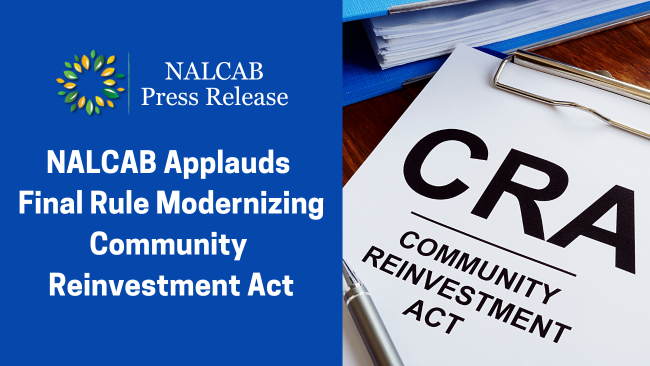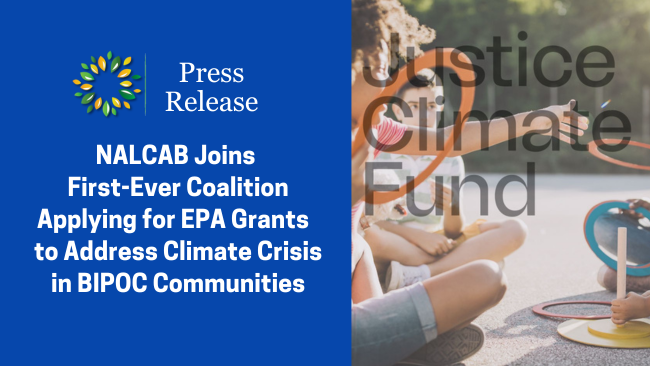
In September the Office of the Comptroller of Currency (OCC) issued an Advance Notice of Proposed Public Rule Making on the Community Reinvestment Act (CRA). The OCC’s plans to rewrite the CRA have raised great concern and have put at risk the well-established intent of CRA: to meet credit needs in low and moderate-income communities.
NALCAB urges its members to comment and protect the CRA from changes that may weaken its effectiveness and change the original intent of the law.
Template Letter:
To: OCC, Ms. Vonda J. Eanes
Director for CRA and Fair Lending Policy Compliance
Office of the Comptroller of the Currency
400 7th Street SW, Washington, DC 20219
Re: Docket ID OCC-2018-0008
Dear Ms. Eanes:
We write to express our deep concern with the Advance Notice of Proposed Rulemaking (ANPR) regarding the Community Reinvestment Act (CRA). The ANPR opens the door to proposals that would undermine the original intent of the CRA – to better meet the credit needs of low- and moderate-income people and communities. We call on the OCC to withdraw the ANPR and to engage collaboratively with stakeholders and the other prudential regulators to develop a process that will amplify the impact of CRA for those it was intended to benefit, rather than lowering the bar for banks in meeting their statutory obligations.
The CRA has been critical for ensuring depository institutions meet credit needs of low- and moderate-income people in the communities they serve. It was a landmark response to red-lining practices that targeted communities of color, practices that continue today. It is a fundamental financial pillar of community and economic development. With the wealth gap growing in this country, CRA is needed now more than ever to ensure equitable investment in low- and moderate income communities.
The evolution of the banking sector, and especially technological change that has transformed the delivery of financial services, has created the opportunity for the CRA to have even greater impact in the communities it was originally intended to serve. There is a need to undertake CRA reform that puts the credit needs of low- and moderate income communities first. Unfortunately, the OCC’s approach to CRA reform represented in this ANPR is fundamentally flawed. The ANPR ignores a decade or more of work around the concept of CRA reform. In collaboration with the OCC and FDIC, the Federal Reserve has been engaged in a multiyear process aimed at reforming the CRA to more effectively meet the credit needs of our nation’s diverse communities and respond to the
evolution of the financial services industry. In May 2016, the Federal Reserve solicited advice on CRA reform from the Community Advisory Council. Interagency Q&As were published in July 2016. Governor Brainard has recently made speeches addressing CRA Reform which outlined specific guideposts that reflect a balance of input from industry and community-serving organizations and that represent a step forward in this discussion that intentionally builds on a robust process.
The simplistic “one ratio” or “one metric” approach to CRA ratings proposed in the ANPR is a poison pill for any package of CRA regulatory change. This approach allows banks to only report the top line amount of CRA investments as a percentage of total assets, eliminating the vast majority of CRA requirements. “One ratio” is a self-policing mechanism that will lower the bar for CRA compliance and reduce investment in low-and moderate-income communities. With more than 96% of banks receiving a satisfactory or better rating, it is clear that the vast majority of the banking industry is not having difficulty meeting the requirements established by existing CRA regulations. There is no reasonable argument that the bar for CRA compliance needs to be lowered. If enacted, the “one ratio” approach will be subject to ongoing question and revision, introducing even greater uncertainty for the banking industry in the CRA examination process.
The ANPR raises a separate, but related, question about whether banks should receive CRA credit for investments and activities that do not target LMI borrowers or areas. Opening up a regulatory debate on whether banks should receive CRA credit for investments that do not focus on non-LMI communities or people undermines the intent of CRA and ignores that CRA was a response to red-lining.
While the ANPR raises proposals that would undermine the original intent and effectiveness of the CRA, it fails to emphasize matters that could contribute to stronger accountability and impact assessment in the CRA rating process, including the following.
Improving CRA Examinations
* The speed and transparency of the CRA rating process should be improved by increasing the number of trained CRA examiners, shortening the exam periods and making bank submissions public upon completion of a CRA exam.
* In order to ensure that CRA ratings are more fully informed by public input, the CRA rating criteria should include a scoring sub-element that rates how a bank engages the public, including organizations that serve LMI communities and consumers in their assessment areas.
* Violations of fair lending and/or consumer protection laws by banks must be considered in their CRA ratings. Ratings must be lower for banks that have a track record of failing to lend to specific racial or ethnic demographics in the markets they serve.
Assessment Areas
* Regardless of a bank’s assessment area, banks should have the flexibility to make up to 10% of their approved CRA lending and investments to benefit LMI people that reside in persistent poverty census tracts located anywhere in the United States or the territories.
Eligible Activities That Benefit LMI People and Communities
* Regulators can provide greater clarity on CRA eligible activities by publishing a best practice guide that is informed by community and consumer serving organizations and obtaining public input on past CRA activities that have received credit and resulted in significant impact for LMI people and communities.
* New or innovative CRA investments proposed by banks should be evaluated and receive pre-approval as “pilot” activities through a process that includes public input and data on the impact of the investment. In order to receive future credit for similar investments, the bank should present actual results and data on the impact of the “pilot” investment.
* Regulators should place a specific emphasis on encouraging focus and innovation on CRA investment that benefit LMI entrepreneurs. This does not need to be achieved by a regulatory requirement, rather regulators can use their power to convene and highlight best practices.
* No more than 10% of a bank’s CRA-credited mortgage lending should be to non-LMI households in LMI census tracts.
* It is appropriate that CRA investments in Community Development Financial Institutions (CDFIs) currently receive a special status in CRA exams. CRA investments for investments that are intended to build the capacity of organizations that are seeking CDFI certification should receive similarly favored review. Submission of an application to the CDFI Fund for a CDFI Technical Assistance grant would be a reasonable test for whether an organization is seeking CDFI status.
CRA Impact Analysis
* There is a difficult balance to be struck between encouraging investment in LMI census tracts and encouraging banks to finance activities for high income people in LMI communities – in effect, financing gentrification. Regulators should analyze aggregated CRA investment by all banks in LMI census tracts, overlaid with data on real estate market appreciation and changing racial/ethnic demographics. Where regulators find clear examples of gentrification, an advisory should be published to limit the eligibility of CRA activities in those census tracts to only lending and investments targeted to LMI people. This analysis can only be successful if it incorporates public input.
Expanding CRA Applicability
* Finally, there should be a more level playing field across the financial services sector with regard to CRA community reinvestment obligations. Non-bank mortgage companies, fintech lenders and credit unions with assets in excess of $2 billion dollars should be subject to CRA obligations and examinations. This expansion of community reinvestment requirements would likely require legislative action; nevertheless, regulators should actively communicate with members of Congress to encourage a more level playing field in the financial services industry by expanding the applicability of CRA.
A strong CRA works to ensure that our economy is healthy, inclusive and equitable. Revisions to CRA regulations must put the credit needs of low- and moderate-income people and communities first.
This ANPR lacks credibility because it places a greater focus on lowering the bar for banks regarding their CRA obligations than on the people that CRA is intended to benefit. We call on the OCC to withdraw the ANPR and engage in a credible and collaborative process to truly strengthen the CRA.
Respectfully,
Your organization/name
The deadline for comments is Monday, November 19th. Submit comment below:
Related Posts
October 27, 2023 at 08:18 pm
NALCAB Applauds Final Rule Modernizing Community R ...Posted by Hallie Chavez
...
October 12, 2023 at 07:32 pm
NALCAB Joins First-Ever Coalition Applying for EPA ...Posted by Sharon Garcia
...
September 08, 2023 at 04:11 pm
NALCAB Applauds Historic Confirmation of Kugler, t ...Posted by Sharon Garcia
...
July 28, 2023 at 02:36 pm
NALCAB Condemns Resolution to Gut Section 1071Posted by Sharon Garcia
...








